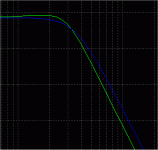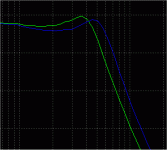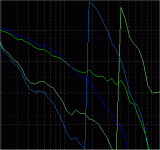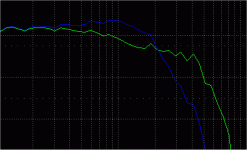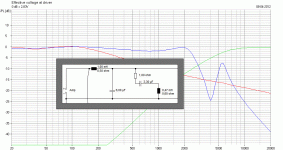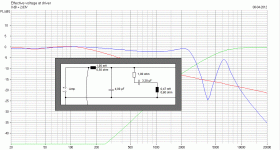Assume for some reason not adequately nailed down,
the owner thinks the crossover can be improved.
rgds, sreten.
Is cheating allowed?
Hi,
Sprinkle your magic on this :

Its a TMM allegedly 2nd order L/R at 3KHz.
Assume for some reason not adequately nailed down,
the owner thinks the crossover can be improved.
rgds, sreten.
With pleasure, my friend. That's the dumbest thing I ever saw, clearly designed by someone who thinks first order crossovers (which fry tweeters and sound harsh because they let all the high frequency breakup rubbish from the woofer through...) are some sort of cool!

Mr. Smart would just go and buy a Visaton prebuilt 2nd order.
Visaton - Lautsprecher und Zubehör, Loudspeakers and Accessories
An externally hosted image should be here but it was not working when we last tested it.
This is designed by the same people who built the magnificent Panzer Tank, so we know it works!
(Let's get back on topic, eh?)
Is cheating allowed?
Hi,
You can cheat
Seeing Strawberry feels qualified to comment on any commercial
crossover posted, just asking for more of the same for that x/o.
Its not a trick question, that x/o can be improved, question is how ?
If you've cheated you probably already know the point of the post.
rgds, sreten.
With pleasure, my friend. That's the dumbest thing I ever saw, clearly designed by someone who thinks first order crossovers (which fry tweeters and sound harsh because they let all the high frequency breakup rubbish from the woofer through...) are some sort of cool!
Mr. Smart would just go and buy a Visaton prebuilt 2nd order.
Visaton - Lautsprecher und Zubehör, Loudspeakers and Accessories
An externally hosted image should be here but it was not working when we last tested it.
This is designed by the same people who built the magnificent Panzer Tank, so we know it works!
(Let's get back on topic, eh?)
Hi,
Yes well you've bitten the bullet and nailed your opinion to the mast,
admirable. This is very on topic as will become readily apparent after
our other crossover expert hopefully does the same, as invited.
rgds, sreten.
Yes. Adding a filter to a driver could make it both more and/or less loud. On that note, since we all learned yesterday that a filter has a 'Q',Right, but in any of the crossover alignments, would removing the filter entirely make any one driver louder? I understand what you're saying, but that's not what he said.
..the topic to study up on should be resonance.there is no need to get nasty.
By the way, designing a speaker to a goal is mostly an exact science, not the Voo-Doo it was once thought by many to be. Strawberry, you sometimes(!) come up with some uncannily good deductions on your own. Yet you seem to undervalue listening, despite your own expectations. This is a fairly steep angle of approach to take within a learned community.

Spendor is generally smoother than Monitor, it is a more laid back sound.
The only Spendors I heard (A6) with Roksan electronics were a it forward for my taste. I have not heard the models listed above. Are the modern Spendors more forward that the older models?
Yup. Spendor use Seas sourced tweeters....
The woofer looked suspiciously like Seas Prestige L series.
5th element, the inductor is about 0.5 mH from the looks of it. 6 uF and 0.5 mH? Disaster.
If it is not specified how can you tell if the inductor is 0.5mh or 1mh just by looking at it?
Even then 0.5mh followed by 6uf wont have Q high enough to cause ringing. In fact I would suspect that a 1 or even 2.2 uf cap in parallel with the exisitng 6uf cap might help drop the upper mids to a level where they become less aggressive.
As strawberry has picked up, the filter rolloffs seem slightly staggered, hence the untidy double hump at crossover.
Maybe this was conciously done (by MA) to compensate for dips and humps in the driver response.
I don't know if it helps but the midrange driver has 5.5 ohms DC resistance and 1867grams weightBass driver has 11.2 ohms DC resistance and 1788 grams weight
I dont know how the weight of the driver affects the frequency response. Mmd/Mms maybe but the weight of the basket, magnet, etc..? Maybe I dont know enough.
Mihai's original requirement was to make the speakers more listenable by taming some HF brashness. That is the goal isn't it?
I dont know why simple tweaks like a felt ring or adding a 1uf cap in parallel with the 6uf cap were not tried. These are easily reversible if they dont work out.
Most similar speakers (KEF, MA, B&W, Focal, etc..) can be tamed by room treatment/placement, plugging ports, felt rings, etc.. A bookshelf here, a throw rug there, etc.. often can help. These are reversible and easier to implement than a complete new crossover design.
My 1.5 cents.
The woofer looked suspiciously like Seas Prestige L series.
Reviews of spender speakers tend to confirm that they use SEAS tweeters. They do tend to state that they make their own mid/bass and woofers, however I think it's more accurate to say that they do outsource to a certain degree. Spenders woofers, especially when seen from behind look very much like SEAS drivers.
If it is not specified how can you tell if the inductor is 0.5mh or 1mh just by looking at it?
Its guesswork more then anything. When you're working with small sizes of less then around 0.5mH you can generally go with an air core without it having to cost ridiculous amounts of money to keep the DCR down. You'd only really swap over to a cored inductor if the inductance was large enough to make the change worth while. That and comparing the coil to others visually, it looks around 1mH, I don't mind being proven wrong though. it is just a guess after all.
Maybe this was conciously done (by MA) to compensate for dips and humps in the driver response.
Indeed.
Hi,
You can cheat, but I'll know and won't be very impressed.
Seeing Strawberry feels qualified to comment on any commercial
crossover posted, just asking for more of the same for that x/o.
Its not a trick question, that x/o can be improved, question is how ?
If you've cheated you probably already know the point of the post.
rgds, sreten.
I did cheat a little, as I was curious to see what sort of speaker Z was working on with this.
The great part about the 2 crossover versions is they could easily be a/b tested with a couple of aligator clips. Plus, after reading what he said about it, I'm almost tempted to try and build this one as my next project.
By the way, designing a speaker to a goal is mostly an exact science, not the Voo-Doo it was once thought by many to be. Strawberry, you sometimes(!) come up with some uncannily good deductions on your own. Yet you seem to undervalue listening, despite your own expectations. This is a fairly steep angle of approach to take within a learned community.
Emphasis mine, this is essentially the reason why I push back so hard on a lot of what Strawberry has said simply because it's just stated, I.E "do this" rather than stated with some reasoning or examples "do this because..". Quite a bit of the hard time I'm giving isn't necessarily because I don't understand the theory at work, but more to encourage some actual explanation on his part, or even poop forbid, a little napkin math. So far, it's only resulted in defensive posturing when that really isn't the point.

It is near 2nd order L/R acoustic at 3KHz for the given drivers.
Hi,
The reason I posted the above is to illustrate how pontificating on a
crossover simply based on the schematic can lead you badly astray,
if you assume the designer is an idiot, and you know a lot better.
Given the x/o appears to be high pass 1st order at ~ 9KHz I'd
of thought that at least would be worthy of "expert" comment.
There is a "better" version, for those that prefer more even tonality :

Point is though no amount of handwaving and debate about the first
version would ever lead to the second version, not enough information.
No argument would lead to the change of the high pass capacitor
value, or the additional response shaping elements to the low pass.
Faced with a crossover you do need to work out whether the original
designer is a muppet or not, here is a classic example of slavishly
adhering to a 1st order electrical x/o design philosophy that
effectively bankrupted the company :
Meadowlark Swift loudspeaker | Stereophile.com
Conversely you can't waffle on about features properly built into good
x/o's as though they are wrong because they are "not right" without
enough information, in my book that is arrogant and ignorant.
rgds, sreten.
I assume D.D. recognised the crossover and its source :
Zaph|Audio
S7's comments and suggested "improvements" are wrong.
SB wisely hasn't bought into being handed a loaded gun with
the safety off so you can shoot yourself in the foot with it.
Same intelligence with his posts would be useful.
Last edited:
The defunct Meadowlark line had the Fried type of sound due to the use of series x/o and t-lines. I am sure they went out of business for the same reasons most companies go out of business.
Most of the high end dealers in my area are gone. I live in the fifth largest metropolitan area in my country. B&W, Thiel, Monitor Audio, ProAc, Krell, Wilson, etc. dealers no more.
There was a dealer in my area, Soundex which closed in 2004. It was the size of an office building with nothing but high end.
I wonder if the same can be said in the U.K. when it comes to the number of high end audio dealers compared to a decade ago ?
Many people in my area have purchased 3-4500 sq. ft. homes and love their Bose surround sound system.
Most of the high end dealers in my area are gone. I live in the fifth largest metropolitan area in my country. B&W, Thiel, Monitor Audio, ProAc, Krell, Wilson, etc. dealers no more.
There was a dealer in my area, Soundex which closed in 2004. It was the size of an office building with nothing but high end.
I wonder if the same can be said in the U.K. when it comes to the number of high end audio dealers compared to a decade ago ?
Many people in my area have purchased 3-4500 sq. ft. homes and love their Bose surround sound system.
The GS20 speakers are good but a little, just a little, to bright... and this brightness somehow covers the mid bass.
Hi roender. I think there are two likely problems here. One is voicing, ie the overall tone of the speaker. This can be good or bad, but even when it is good, it is still down to a matter of personal taste.
Secondly there is your room placement and room treatments. Rooms can make a mess of the mid/bass region contributing to thin or heavy sound, sibilance issues, and other annoying qualities.
There is some benefit to you obtaining an equaliser (even temporarily). It would help you to identify most of your problems here and to fix some of them.
To keep it short, your best first move in my opinion would be to take a look at the response from your listening position. This will give you a clue as to general middle and upper range issues.Can I get your short guide on making useful loudspeaker measurements when using ARTA, please?
Thanks,
Mihai
Set ARTA to spectrum analyser. Have your mic positioned at your listening position and press record, then move your mic sideways until your treble shows that it is properly centred.
Change to Impulse measurement and record a log sweep. In the time sequence that shows up you should be able to see the initial impulse, and might be able to make out the early relfections. By varying the gating time you can focus on different issues.
For example, try to find the quiet patch after the main impulse but before the first big reflections, and set your gate just before those reflections. Do a single gated analysis and set this as an overlay, then do a dual gated analysis. There ought to be some useful information there already.
Attachments
I believe many on the thread already knew that reducing the capacitance in a second order low pass filter increases damping but also increases the higher frequency content. (shown textbook, and with a real woofer impedance)when that really isn't the point.
Attachments
Actually the opposite happens, you need to simulate to see it like I did, for my amazement.I believe many on the thread already knew that reducing the capacitance in a second order low pass filter increases damping but also increases the higher frequency content. (shown textbook, and with a real woofer impedance)
Also, as was referred a second order (+cap) on the woofer would also alleviate from top brightness/breakup peaks.
I would also make probably a third order on the tweeter, +for phase matching.
Last edited:
I'm prepared to back up what I said in theory. If you have a practical example that goes the other way, I'd be interested in seeing it.Actually the opposite happens, you need to simulate to see it like I did, for my amazement.
Chances are moderately good that it will, but fair that it may increase the response around resonance. Then the resultant phase change will not be of the nature that can be corrected by swapping polarity.Also, as was referred a second order (+cap) on the woofer would also alleviate from top brightness/breakup peaks.
Have your time.I'm prepared to back up what I said in theory. If you have a practical example that goes the other way, I'd be interested in seeing it.
What's your plan, Dave? Now I'm getting confused.Chances are moderately good that it will, but fair that it may increase the response around resonance.
[Also polarity and phase might be something difficult to preview without a better more accurate simulation, but we/I work with what we/I already have (no data for frd-zma's/inductors) like size/dimensions of speaker, approx. drivers positions and some crossover data]
Adding a capacitor may reduce damping, similar to the blue trace in the second example using a smaller inductor, or may succeed, using a larger inductor like the first example. (I named the files backwardWhat's your plan, Dave? Now I'm getting confused.&

The phase now incorporates the extra component and a theoretical extra 90 degrees, which is typical. It's shape has changed and will not match either with or without a phase reversal.
The above would be true if the phase were a reasonable match to begin with, as it probably is...but if it were not, then what hope is there regardless. I considered these possibilities before posting earlier.[Also polarity and phase might be something difficult to preview without a better more accurate simulation, but we/I work with what we/I already have (no data for frd-zma's/inductors) like size/dimensions of speaker, approx. drivers positions and some crossover data]
I'm sorry, what did you mean with this?Have your time.
Attachments
Last edited:
The above would be true if the phase were a reasonable match to begin with, as it probably is...but if it were not, then what hope is there regardless.
Just saying. Had to scan the images.I'm sorry, what did you mean with this?
0.5dB atten.@1000Hz
1dB atten.@2000Hz
This data is verified with the data available for simulation. Taking into account output+phase final frequency output is in another graph not shown.
Attachments
Last edited:
A little (big) credit should be given to strawberry.
He is right until prove innocent.
Hi,
Right about what ?
rgds, sreten.
From what I remember:Hi,
Right about what ?
rgds, sreten.
1. Lowering crossover frequency with 6uF on tweeter.
2. 4uF on the midwoofer, now available from tweeter, gives a better handling at lower crossover band.
3. And finally the second order for the woofer, to prevent some of the breakup.
You can find a crossover I designed a little wild ago, that had that in mind, with 2xDynavox LW6004PMR 6-1/2" woofers and a Vifa DX25TG-05-04 tweeter.
http://www.diyaudio.com/forums/multi-way/163796-some-design-help-please.html#post2131776
- Status
- This old topic is closed. If you want to reopen this topic, contact a moderator using the "Report Post" button.
- Home
- Loudspeakers
- Multi-Way
- Please help for Monitor Audio GS20 crossover tuning

